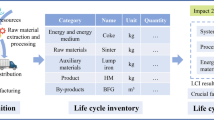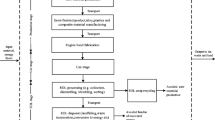Abstract
Purpose
There has been an increasing use of plastic motor car fuel tanks in recent decades with the expected benefits of lighter weight, shape flexibility and lower cost. In this paper, the environmental life cycle assessments of mild steel and high-density polyethylene (HDPE) car fuel tanks in Japan are compared for two cases, namely the current average processes (base case), and for the same processes with the maximum currently feasible pollution control technology installed.
Materials and methods
Primarily, data from Japan are used for a life cycle inventory analysis, followed by an impact assessment based on the Life Cycle Impact Assessment Method Based on Endpoint Modelling and five other indicators.
Results and discussion
Mild steel shows a notably higher inventory for resources iron, manganese, zinc, coking coal, combustion coal, dolomite, limestone; for the air pollutants nitrogen oxides (NOx) from mobile sources, PM10, sulphur dioxide, hydrocarbons; and for solid waste (slag). HDPE has a higher inventory for resources liquefied natural gas reserves, oil reserves, for the air pollutants carbon dioxide, NOx from non-mobile sources and sulphur oxides. The base case environmental impact assessment results for six indicators show HDPE and steel to have similar impacts for all but one of the indicators. With pollution control, the feasible reductions in respective pollutant inventories range from 0% to 97%, while the corresponding impact assessment shows indicator values reduced by 0% to 29%, with slightly improved performance of mild steel relative to HDPE.
Conclusions
Accounting for a 62-year period of use and recycling for the mild steel would show a further decrease in the impact of the mild steel relative to HDPE.

Similar content being viewed by others
References
Aarnink AJA, van Hattum T, Hol A, Zhao Y (2007) Reduction of fine dust emission by combi-scrubber of Big Dutchman. A study funded by the Dutch government ministries LNV and VROM. http://www.asg.wur.nl/NR/rdonlyres/F81D8745-6596-4296-A292-8553950E2B98/48334/66E.pdf, published August 2007, accessed July 2009
Alvarado PJ (1996) Steel vs. plastics: the competition for light-vehicle fuel tanks. JOM 48(7):22–25
Bellmann K, Khare A (1999) European response to issues in recycling car plastics. Technovation 19(12):721–734
Bengtsson M, Steen B (2000) Weighting in LCA—approaches and applications. Environ Prog 19(2):101–109
Brogren C, Karlsson HT (1998) Modeling the absorption of SO2 in a spray scrubber using the penetration theory. Chem Eng Sci 52(18):3085–3099
Burtraw D, Palmer K, Bharvirkar R, Paul A (2001) Cost-effective reduction of NOX emissions from electricity generation. Resources for the Future, Washington D.C., Discussion paper 00–55REV, July 2001
CBPR (2009) Embodied energy coefficients–alphabetical. Centre for Building Performance Research University of Wellington, Victoria, New Zealand. http://www.victoria.ac.nz/cbpr/documents/pdfs/ee-coefficients.pdf, accessed July 2009
EDMC (2008) Handbook of energy and economic statistics in Japan. The Energy Data and Modelling Center, The Institute of Energy Economics, Japan
Ehsan Md, Al Nur M (2003) Controlling emissions from conventional road transports: Dhaka situation. Proceedings of the International Conference on Mechanical Engineering 2003 (ICME2003), 26–28 December 2003, Dhaka, Bangladesh
ELCD (2007) The European reference life cycle data system. European Commission. http://lca.jrc.ec.europa.eu/lcainfohub/datasetArea.vm, published 2007, accessed October 2008
Forzatti P (2001) Present status and perspectives in de-NOx SCR catalysis. Appl Catal A: Gen 222(1–2):221–236
Hayashi Y, Kato H, Teodoro RVL (2001) An analysis of the effects of car and fuel taxes on CO2 emissions in Japan and Germany. In: Transportation, Energy and Environmental Policy: managing transitions. The Transportation Research Board, Washington DC
Hendrickson CT, Lave LB, Matthews HS (2006) Comparison of steel and plastic fuel tank systems for automobiles, chapter 7. In: Environmental life cycle assessment of goods and services: an input–output approach. RFF Press, Baltimore
Holt GA, Baker RV, Hughs SE (1999) Evaluation of static pressure drops and PM10 and TSP emissions for modified 1D-3D cyclones. ASAE Annual International Meeting. Paper by Holt GA, Baker RV, Hughs SE, published July 19, 1999
Hunkeler D, Yasui I, Yamamoto R et al (1998) LCA in Japan: policy and progress. Int J Life Cycle Assess 3(3):124–130
Itsubo N, Inaba A (2003) A new LCIA method: LIME has been completed. Int J Life Cycle Assess 8(5):305
JEMAI (2008) JEMAI LCA-Pro database and software. The Japan Environmental Management Association for Industry (JEMAI), Tokyo, Software version purchased September 2008
Joshi S (1999) Product environmental life-cycle assessment using input-output techniques. J Ind Ecol 3(2–3):95–120
Kaspar J, Fornasiero P, Hickey N (2003) Automotive catalytic converters: current status and some perspectives. Catal Today 77(4):419–449
Keoleian GA, Spatari S, Beal R (1997) Life cycle design of a fuel tank system. National Risk Management Laboratory, US Environmental Protection Agency. http://www.p2pays.org/ref/07/06431.pdf, accessed January 2009
Keoleian GA, Spatari S, Beal RT, Stephens RD, Williams RL (1998) Application of life cycle inventory analysis to fuel tank system design. Int J Life Cycle Assess 3(1):18–28
Keoleian GA, Blanchard S, Reppe P (2000) Life-cycle energy, costs, and strategies for improving a single-family house. J Ind Ecol 4(2):135–156
Lave LB, Joshi S, Maclean HL, Horvath A, Hendrickson CT, McMichael FC (1998) Environmental input-output life cycle analysis: a summary of results including a comparison with SETAC approach. Total life cycle conference and exposition. The Engineering Society for Advancing Mobility Land Sea Air and Space International, Graz
Matsuno Y, Daigo I, Adachi Y (2007) Application of Markov chain model to calculate the average number of times of use of a material in society. An application methodology for open-loop recycling: part 2: case study for steel. Int J Life Cycle Assess 12(1):34–39
MIT (2008) On the Road in 2035: reducing transportation’s petroleum consumption and GHG emissions. Report by MIT Laboratory for Energy and the Environment. http://web.mit.edu/sloan-auto-lab/research/beforeh2/otr2035/, Massachusetts Institute of Technology, Cambridge, Massachusetts
Motz H, Geisele J (2001) Products of steel slags an opportunity to save natural resources. Waste Manage 21(3):285–293
Mouzakis DE, Karger-Kocsis J (1998) Effects of gasoline absorption on the tensile impact response of HDPE/SelarTM laminar microlayer composites. J Apply Poly Sci 68(4):561–569
Nippon Steel (2009) Mainly fuel tank finishing data obtained through private communication with Nippon Steel Corporation of Japan, Kitakyushu Factory
Norgate TE, Rankin WJ (2002) The role of metals in sustainable development. CSIRO metals, Australia. http://www.minerals.csiro.au/sd/CSIRO_Paper_LCA_Sust.pdf, accessed October, 2008
Product Ecology Consultants (2009) The Eco-indicator 95, Final Report. Pre, Amersfoort, The Netherlands. http://www.pre.nl/download/EI95FinalReport.pdf, accessed July 2009
Product Ecology Consultants (2010) LCA data in SimaPro. Pre, Amersfoort, The Netherlands. http://www.pre.nl/simapro/inventory_databases.htm, accessed July 2010
Stephens RD, Williams RL, Keoleian GA, Spatari S, Beal R (1998) Comparative life cycle assessment of plastic and steel vehicle fuel tanks. Presented at total life cycle conference and exposition. The Engineering Society for Advancing Mobility Land Sea Air and Space International, Graz
Tufts (2008) Note on steel embodied energy. Tufts University, Massachusetts, USA. http://www.tufts.edu/tie/SGH/recycledmaterials.htm, accessed December 2008
Tung C-y, Wang MH (2002) Comparison of environmental performance between plastic and steel fuel tanks. Proc IME B J Eng Manufact 216(11):1443–1457
University of Massachusetts (2008) Note on differences in energy required to make virgin and recycled steels. http://www.umass.edu/recycle/recycling_benefits.shtml, accessed December 2008
Ushiyama I (1999) Wind energy activities in Japan. Renew Energ 16(1–4):811–816
Yamato M, Mituhara Y (1997) Life Cycle Inventory Study of Automotive Fuel Tank. Report by Masako Yamato and Yoshihito Mituhara of Toyota Motor Corporation. www.sae.org (document number 971177), accessed October, 2008
Acknowledgements
We wish to thank the National Research Foundation (NRF) of South Africa and the Ministry of Education, Culture, Sports, Science and Technology (MEXT) of Japan for making this research possible.
Author information
Authors and Affiliations
Corresponding author
Electronic supplementary materials
Below is the link to the electronic supplementary material.
ESM 1
(DOC 258 kb)
Rights and permissions
About this article
Cite this article
Dlamini, N.G., Fujimura, K., Yamasue, E. et al. The environmental LCA of steel vs HDPE car fuel tanks with varied pollution control. Int J Life Cycle Assess 16, 410–419 (2011). https://doi.org/10.1007/s11367-011-0277-7
Received:
Accepted:
Published:
Issue Date:
DOI: https://doi.org/10.1007/s11367-011-0277-7




